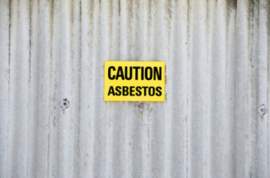
Asbestos and Your Health

Must Read
Asbestos and Your Health: What you Need to Know What is Asbestos? Asbestos is the colloquial name given to a group of six different naturally-occurring minerals (amosite, tremolite, actinolite, chrysotile, anthophyllite and crocidolite). The most common form of asbestos is white chrysotile, but other minerals may be gray (anthophyllite), blue (crocidolite) or brown (amosite). These naturally-occuring minerals are composed of long, thin fibers that look similar to fiberglass. An asbestos fiber is resitant to heat and chemicals. The mineral is incredibly strong. Because of these desirable characteristics, asbestos fibers were widely used in a number of products, most notably friction products, building materials and heat-resistant fabrics. Due to the mineral’s resistance to chemicals, the mineral is very stable in the environment; asbestos does not evaporate into the air or dissolve in water. Moreover, asbestos does not break down over time. How Would I be Exposed to Asbestos Fibers? You are most likely to be exposed to asbestos fibers by breathing in microscopic asbestos dust that has become airborne. These dust particles come from natural outcroppings of asbestos; when asbestos products are damaged or disturbed, the mineral releases these tiny particles into the air. The bulk of asbestos exposure results from the degradation of man-made asbestos products, such as ceiling and floor tiles, insulation, cement, roof shingles, automotive clutches, breaks and other products. In indoor settings, concentration of asbestos is dependent on whether the mineral was used for ceiling, floor tiles, insulation or other purposes and whether or not these asbestos-containing materials are in stable condition or are susceptible to fragmentation or crumbling. Individuals who work with asbestos products (for example insulation workers, miners, and automobile brake mechanics) are susceptible to asbestos exposure. Moreover, the level of exposure for these occupations is excessive; these occupations are likely to be exposed to deadly levels of airborne asbestos particles than individuals who work, live or attend school in areas containing asbestos products. You may also be exposed to asbestos products to asbestos products from loved ones who work in the occupations or listed above or from simply drinking water—asbestos is a naturally-occurring mineral that can infiltrate water systems. Even though asbestos fibers do not dissolve in water, the filaments may enter water through the erosion of natural deposits or from cement pipes that are used to carry drinking water. How Does Asbestos Enter my Body? If you are in contact with airborne asbestos fibers, you will breathe in the dust. When inhaled, the asbestos fibers enter your lungs. Some of these fibers are deposited in the air passages and on the actual cells that comprise your lungs. However, very few of these asbestos fibers will travel through your lungs and into your body. Instead, the majority of asbestos fibers will leave your lungs by being extracted through a layer of mucus to the throat, where they are then ingested into the stomach. This process takes place within a few hours of asbestos exposure. It must be stated, that the fibers deposited in the depths of the lungs are removed at a more gradual pace. In fact, some of these asbestos fibers may remain in place for decades following the initial exposure to asbestos dust. If you swallow asbestos dust particles (either from drinking contaminated water or from airborne asbestos exposure), the majority of the fibers will pass along your intestines within a few days and be expelled in your feces. A small percentage of these asbestos fibers will stick in the cells that line your intestines or stomach. An even smaller percentage of these asbestos fibers will penetrate the lining and infiltrate the blood stream. Some of these fibers may even become trapped in other cell structures. How Will Asbestos Exposure Affect My Health? The United States Department of Health and Human Surfaces affirms that asbestos is a known carcinogen. The government body states that asbestos, through perpetual exposure, will cause cancer in human beings. An asbestos fiber, according to the government, imposes serious effects on your health when perpetually inhaled. Currently, there is no known safe exposure to asbestos fibers. The greater the exposure (the longer you are exposed or the more asbestos you are exposed to), the greater the risk of developing an asbestos-related cancer. Information regarding the health effects of asbestos in humans derives mostly from studies of individuals who were exposed in the past to exorbitant levels of asbestos in the workplace. Asbestos workers, in fact, are found to have increased chances of developing two types of cancer: mesothelioma (a cancer of the thin membrane that shields the lung and other vital organs in the body) and the cancer of the lung tissue itself. Both forms of asbestos cancer (lung cancer and malignant mesothelioma cancer) are typically fatal. Bleak life expectancy is tied-into the cancer’s lengthy latency periods: the amount of time between the person’s first exposure to asbestos and the first signs of an asbestos-related disease can be as much as three decades. Moreover, it is known that cigarette smokers exposed to asbestos materials have a far greater chance of developing an asbestos-related disease (particularly lung cancer) than just from smoking alone. As stated above, asbestos-related diseases do not appear immediately—it takes typically 20-30 years for these cancers to become noticeable. Evidence suggests that workers who constantly breath-in asbestos can face an increased chance of developing the cancer in other locations (for example the stomach, esophagus, intestines, kidneys and pancreas). Members of the general public who are exposed to lower levels of asbestos fibers may also develop a related cancer; however, the risks are typically small and are difficult to accurately measure. In addition to causing cancer, asbestos inhalation can cause a slow accumulation of scar tissue in the lungs and the protective tissues surrounding the lungs. Scar tissue does not expand and contract like a health lung tissue. This obviously complicates the breathing process. Additionally, blood flow to the lungs may decrease, ultimately leading to heart enlargement. When the exposure injures the lung itself, the disease is referred to as asbestosis. This is a serious medical condition and may eventually lead to severe disabilities or even death—asbestosis is typically fatal for people who experience high levels of asbestos exposure. However, it must be noted, that asbestosis is not typically a concern to people exposed to low levels of asbestos—the disease is typically found in individuals who have spent decades working with asbestos containing materials. In a similar fashion, an injury to the membrane surrounding the lungs is common in asbestos workers. This condition is not life threatening; it only complicates breathing. Health effects from swallowing asbestos particles are unclear—some groups of individuals who have drank an abnormal amount of asbestos possess higher-than-average death rates, typically derived from cancer of the stomach, esophagus and intestines. However, it is exceedingly complicated to decipher whether this elevated death rate is caused by an asbestos-related disease or by something else. When asbestos particles penetrate the skin, non-malignant warts (appropriately labeled as asbestos warts) may result. What Levels of Asbestos Exposure Yield Harmful Side Effects? The United States Government institutes no safe exposure threshold (with regards to inhaling asbestos fibers) has been formally established. That being said, the government clearly states the risks of developing an asbestos related disease typically increases with the amount of exposure and the length of exposure. Another primary factor which increases the risk of developing an asbestos-related disease is cigarette smoking. As stated above, drinking or eating asbestos dust may increase the risk of developing asbestos cancer, but this link is not firmly established. Drinking or eating asbestos fibers is not believed to cause any harmful effects. Are there Diagnostic Tests to Determine Whether I have been exposed to Asbestos? The most common diagnostic tests used to determine if you have been exposed to harmful levels of asbestos is a chest X-ray. This diagnostic test will not be able to detect the fibers themselves, but can observe early signs of lung disease caused by asbestos particles. While other agents besides asbestos particles may sometimes produce similar alterations in the lungs, this diagnostic test is typically reliable for detecting asbestos-related side effects. It is highly possible to test for the presence of asbestos particles in feces, mucus, urine or any materials rinsed out of the lungs by a medical professional. Low levels of asbestos particles are found in these excretions in nearly all human beings. A higher-than-average asbestos level will reveal that you been exposed to too much asbestos; however, this determination is not yet possible to use the results to estimate how much of the dust you have been exposed to. Additionally, these observations cannot predict whether you are likely to suffer from any related health defects. Despite an ongoing debate that centers around the health effects resulting from the different forms of asbestos fibers, the Agency for Toxic Substances and Disease Registry considers the different asbestos forms to be known as human-cancer substances with an extended latency period of between 20 and 30 years from the initial exposure to the onset of the disease. If you have any additional questions or concerns regarding asbestos exposure, you must contact your local health or environmental department. For other inquiries please contact the Agency for Toxic Substances and Disease Registry. This government agency may provide you with additional information including the location of the nearest occupational and environmental health clinic in your state. These clinics specialize in evaluating, recognizing and treating asbestos conditions or illnesses that derive from exposure to hazardous chemicals and/or substances.



















